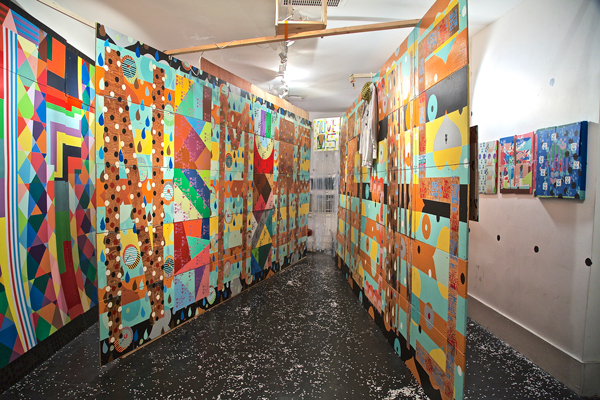So I was at this opening—or maybe it was an event. In a project space. Or maybe it was a party. There were paintings. It was definitely not an installation. Or, okay: there were things installed in it and the whole space had been taken over and changed but it was not just an installation—because within it there were distinct works. I mean, the walls were graffitied, and the art was graffiti, and there were new walls that were clearly put up in order to be graffitied, but then also on the walls there were separate and distinct squares with what were definitely paintings. I mean I have an MFA and I am pretty sure I could call them separate paintings. Also then there was a performance—but it was later. There were some rappers. But there was a DJ the whole time. Also there was a video—but the video was separate from the performance, it was on a screen on its own in a different part of the room. Also there were some really big paintings which were kind of walls but I am pretty sure that whatever it was when it came down, then they wouldn’t really be separate things any more so they were maybe installation parts but not paintings even though they were bigger than the paintings, and like them.
You know what I mean?
This is a specific way of showing art that anyone who has spent any time around art in the last 20 years will recognize. Often (but not always) the artists are street artists and often (but not always) the spaces are scrappy alternative spaces. The show itself is neither a display of discrete works in a white showroom nor full-on installation art with each piece fully subjugated to a whole walkthrough experience. The space is besieged, but transformed unevenly and not seamlessly, and is above all attacked not so much by a specific tool but by a sensibility.
The apparent simplicity of an omnivorous artist’s drive to turn a room into a sketchbook conceals complexities in this still unnamed medium or meta-medium. It references the way a piece of street art interacts with its street—the work needs an indeterminate amount of not-the-work around it in order to work. Unless it’s experienced as a photo, the viewer decides how much of the surrounding city scene is vital context and how much is just a fire escape near the art.

Installation at LAST Projects gallery by Xara Thustra, “Queer, Trans, Spaces,” photo by Ilona Berger.
The show/installation/party/event/space-siege piles layers onto this relationship: you can decide the painting or sculpture on the wall is the art, you can decide these pieces plus the (less painted, but still painted) wall they’re together in front of is the art, you can decide the room is the art, you can decide the event is the art or you can decide that moment in time with all that happening is the art (and any other visit to that space is just looking at a corpse). More divisively: if you want to evaluate it (as buyer, as critic), you have to make this decision. How much of it do you wall off as “not the main thing” or “presentation?” How much of this do you want? Do you want to blame the artist for the parts you don’t want?
There’s an optimistic and interactive reading of this interpretive interaction, but there’s also an element of theater. Actual street art defies a purely functional reading of an everyday space: someone is paying for that property to do a specific thing, and the people walking past are expecting that thing—and the art is repurposing it. All good street art takes for granted its status as counter-programming, both visually and thematically—something to be discovered—the same way a book takes an undistracted and seated reader as a premise. Translated to a gallery, though—you can’t vandalize your own show. The viewer wouldn’t even be in the room if they didn’t expect to see the art—so the art is defying at least one less expectation than it was when it was outside, and is surprising in one less way.
This may be why these kinds of shows always spill so easily into happenings: on the street, the art is disrupting the street’s claim to be just a street, the gallery performance disrupts the art show’s claim to just be an art show, making it into a set, a backdrop—and then the party disrupts the performance’s clean claim to begin, go as planned, and end. The artists intuit that if something isn’t genuinely disrupted—or at least put in motion against something else, the gestures that worked outside won’t work anymore. The fact that the viewer has to actively choose to stop looking at the loud moving thing and start looking at the thing on the wall isn’t a bug—it’s an essential feature.
Image courtesy LAST Projects gallery in Los Angeles, http://lastprojects.org

